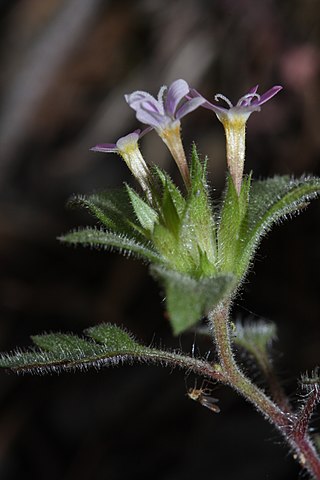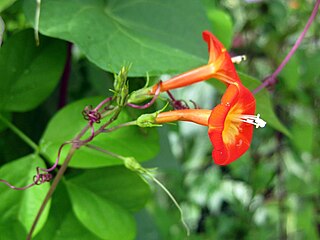
Sanguisorba is a genus of flowering plants in the family Rosaceae native to the temperate regions of the Northern Hemisphere. The common name is burnet.

Phacelia fremontii is a flowering plant in the family Boraginaceae native to the southwestern United States. In California, its range includes the Mojave Desert, the San Joaquin Valley, the Coast Ranges, and the Sierra Nevada. It was named for John C. Frémont.

Limnanthes, the type genus of the family Limnanthaceae, consists of annual herbaceous plants commonly known as the meadowfoams. The seven species are all native to coastal and adjoining regions of western North America, where they typically grow in marshy habitats, such as the margins of vernal pools. Some are endemic to California.

Descurainia pinnata is a species of flowering plant in the family Brassicaceae known by the common name western tansymustard. It is native to North America, where it is widespread and found in varied habitats. It is especially successful in deserts. It is a hardy plant which easily becomes weedy, and can spring up in disturbed, barren sites with bad soil. This is a hairy, heavily branched, mustardlike annual which is quite variable in appearance. There are several subspecies which vary from each other and individuals within a subspecies may look different depending on the climate they endure. This may be a clumping thicket or a tall, erect mustard. It generally does not exceed 70 centimeters in height. It has highly lobed or divided leaves with pointed, toothed lobes or leaflets. At the tips of the stem branches are tiny yellow flowers. The fruit is a silique one half to two centimeters long upon a threadlike pedicel. This plant reproduces only from seed. This tansymustard is toxic to grazing animals in large quantities due to nitrates and thiocyanates; however, it is nutritious in smaller amounts. The flowers are attractive to butterflies. The seeds are said to taste somewhat like black mustard and were utilized as food by Native American peoples such as the Navajo.

Potentilla recta, the sulphur cinquefoil or rough-fruited cinquefoil, is a species of cinquefoil. It is native to Eurasia but it is present in North America as an introduced species, ranging through almost the entire continent except the northernmost part of Canada and Alaska.

Fumaria muralis, known as common ramping-fumitory or wall fumitory, is a flowering herbaceous plant in the poppy family (Papaveraceae) native to western Europe and northwestern Africa.

Cleomella plocasperma is a species of flowering plant in the cleome family known by the common name twisted cleomella and alkali stinkweed. It is native to the Great Basin and Mojave Desert in the western United States, where it grows mainly in wet, alkaline soils such as those around hot springs. There is a disjunct population in the Bruneau Valley of southwestern Idaho. It grows with other halophytic species such as saltgrass and greasewood. This is an annual herb producing a smooth, hairless stem which divides into several erect or upright branches which may exceed half a meter tall. The sparse leaves are each split into three narrow leaflets. The flowers occur in a raceme at the top of each stem branch. Each flower has four yellow petals and several long stamens which may be over a centimeter long. The fruit is a capsule with large lobes. It hangs at the tip of the remaining flower receptacle.

Collomia heterophylla is a species of flowering plant in the phlox family known by the common name variableleaf collomia. It is native to western North America from British Columbia to Idaho to central California, where it grows in several types of habitat, including open areas on gravelly mountain slopes. It is a hairy annual herb producing a branching, erect stem. As the common name suggests, the leaves are variable in shape, the lower generally with several toothed lobes and the upper sometimes lacking lobes. The inflorescence is a cluster of flowers emerging from the top of the stem or from the axil of a leaf. It may bear up to 25 flowers, each with star-shaped corolla at the tip of an elongated tube. The corolla lobes are lance-shaped and white to deep pink with white bases.
Horkelia wilderae is a rare species of flowering plant in the rose family known by the common name Barton Flats horkelia. It is endemic to San Bernardino County, California, where it is known from only about ten occurrences in the vicinity of Barton Flats. It grows in the montane chaparral and woodlands habitat where chaparral meets pine forest, and it is threatened by logging.

Ipomoea coccinea is a flowering plant in the family Convolvulaceae known by several common names including red morning glory, redstar and (ambiguously) Mexican morning glory.

Phacelia davidsonii is a species of phacelia known by the English name Davidson's phacelia named by Asa Gray for the discoverer of this annual plant, Anstruther Davidson, a Scottish naturalist who emigrated from Scotland to Los Angeles, California, in the late nineteenth century. This native forb occurs in southern California and southern Nevada, where it grows in mountains and foothills in chaparral and woodland habitats. In California, this herb is found in the Southern Sierra Nevada, Transverse Ranges, and Peninsular Ranges.

Polemonium chartaceum is a rare species of flowering plant in the phlox family known by the common names Mason's Jacob's-ladder and Mason's sky pilot. It is native to California, where it has a disjunct distribution. It occurs in the Klamath Mountains as well as the ranges east of the Sierra Nevada, including the White Mountains, where its distribution extends just into Nevada. It is a plant of high elevations, growing in exposed, rocky mountain slope habitat such as talus and alpine fellfields.

Potentilla norvegica is a species of cinquefoil known by the common names rough cinquefoil, ternate-leaved cinquefoil, and Norwegian cinquefoil. It is native to Europe, Asia, and parts of North America, and it can be found elsewhere as an introduced species.

Ranunculus muricatus is a species of buttercup known by the common names rough-fruited buttercup and spinyfruit buttercup. It is native to Europe, but it can be found in many other places in the world, including parts of Africa, Australia, and the western and eastern United States, as an introduced species and agricultural and roadside weed. It grows in wet habitats, such as irrigation ditches. It is an annual or sometimes biennial herb producing a mostly hairless stem up to half a meter long which may grow erect or decumbent along the ground. The leaves have blades a few centimetres in length which are deeply divided into three lobes or split into three leaflets. They are hairless to hairy in texture, and are borne at the tips of long petioles. The flower has five shiny yellow petals under 1 centimetre (0.4 in) long around a lobed central receptacle studded with many stamens and pistils. The fruit is a spiny achene borne in a spherical cluster of 10 to 20.

Rapistrum rugosum is a species of flowering plant in the mustard family known by the common names annual bastardcabbage, common giant mustard or turnipweed. It is native to Eurasia and parts of Africa, and it is present throughout the world as an introduced species and a common weed. It is an invasive species in many areas. It is an annual herb producing an erect stem reaching up to about a meter tall. The leaves are variable in shape and size and the proximal blades are generally cut into lobes or divided into leaflets. The herbage is coated in rough hairs. The inflorescence is a raceme of flowers with dark-veined yellow petals that are each under a centimeter long. The fruit is a knoblike spherical ribbed silique borne on a long pedicel with a widened area where it joins the fruit.
Sibara virginica is a species of flowering plant in the family Brassicaceae known by the common name Virginia winged rockcress. It is native to North America, where it can be found throughout the southeastern quadrant of the United States and in California and Baja California in the west. It grows in many types of habitat, including disturbed areas. It is an annual or biennial herb producing a basal rosette of leaves with comblike blades so deeply divided into many lobes that they may appear to have leaflets. It bolts one or more erect stems up to 30 centimeters tall. The flowers each have four spoon-shaped white petals a few millimeters long and purplish sepals. The fruit is a flattened, elongated silique up to 2.5 centimeters long containing tiny seeds.

Trifolium angustifolium is a species of clover known by the common names narrowleaf crimson clover, narrow clover and narrow-leaved clover.

Trifolium obtusiflorum is a species of clover known by the common name clammy clover. It is native to California in the Peninsular, Transverse, Sierra Nevada, and the California Coast Ranges and Cascade Range into southwestern Oregon.

Thalictrum cooleyi is a rare species of flowering plant in the buttercup family known by the common name Cooley's meadow-rue. It is native to the southeastern United States, where it is present in North Carolina, Georgia, and Florida. It is threatened by habitat destruction and degradation. It is a federally listed endangered species of the United States.
Hevea guianensis is a species of rubber tree in the genus Hevea, belonging to the family Euphorbiaceae. It is native to the rainforests of Ecuador, Venezuela, the Guyanas, Brazil, Colombia and Peru. It generally grows on well-drained soils or on those that are only lightly inundated, on river banks, in gallery forests, savannah forests and wooded slopes.

















